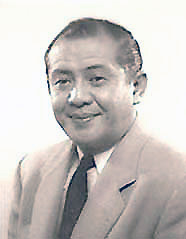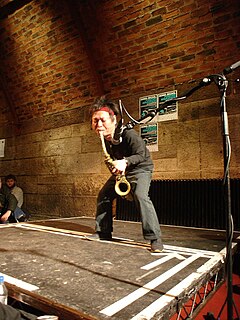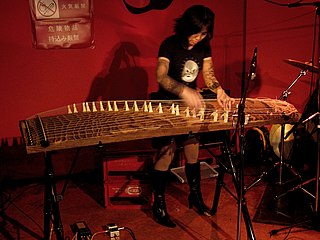 W
WThe komusō were a group of Japanese mendicant monks of the Fuke school of Zen Buddhism who flourished during the Edo period of 1600–1868. Komusō were characterized by a straw bascinet worn on the head, manifesting the absence of specific ego. They were also known for playing solo pieces on the shakuhachi. These pieces, called honkyoku, were played during a meditative practice called suizen, for alms, as a method of attaining enlightenment, and as a healing modality. The Japanese government introduced reforms after the Edo period, abolishing the Fuke sect. Records of the musical repertoire survived, and are being revived in the 21st century.
 W
WAkira Fujioka , better known by his stage name of Afra, is a Japanese beatboxer from Suita, Osaka. He formed the beatboxing band Afra & Incredible Beatbox Band in 2005 with Kei and K-Moon. He had a guest appearance alongside Kōichi Yamadera in the eighth episode of the anime Samurai Champloo as the voice of the beatboxing Shinpachi.
 W
WMark de Clive-Lowe is an American-based Japanese—New Zealand DJ, musician, composer and producer raised in Auckland and now based in Los Angeles, California.
 W
WFujiwara no Moronaga was a Japanese politician, noble and musician during the Heian era. He was also known as Myo-On-In Daishokoku.
 W
WGeisha (芸者), geiko (芸子), or geigi (芸妓) are a class of female entertainers from Japan trained in traditional styles of performing art, such as Japanese dance and singing. Their distinct appearance is characterized by long, trailing kimono, traditional hairstyles and the oshiroi make-up. Contrary to popular belief, geisha are not prostitutes; a misconception originating in the West due to interactions with oiran, whose traditional dress was similar to that of geisha.
 W
WGoze (瞽女) is a Japanese historic term referring to visually-impaired Japanese women, most of whom worked as musicians.
 W
WKatsuhiko Haida was a Japanese film actor and music composer. He played an important role in the 1951 Tokyo File 212. He has also appeared in The Burning Sky, and Escapade From Japan. His brother is Yukihiko Haida, and they formed the Nihon Ukulele Association together.
 W
WYukihiko Harry Haida was a composer, as well as a steel guitar and ukulele player. He and his brother Katsuhiko Haida founded the Nihon Ukulele Association.
 W
WEitetsu Hayashi is an acclaimed Japanese musician best known for his solo performance work in taiko. Hayashi joined the group Ondekoza at an early age. Later, after parting from group, helped found the taiko group Kodo, though he quickly left to begin a solo career. Hayashi has performed in notable venues such as Carnegie Hall in 1984 and was the first featured taiko performer at the institution. He is also the recipient of multiple awards recognizing the cultural value of his work.
 W
WKonishiki Yasokichi is an American former sumo wrestler of Samoan descent. He was the first non-Japanese-born wrestler to reach ōzeki, the second-highest rank in the sport. During his career he won the top division championship on three occasions and came close to becoming the first foreign-born grand champion, or yokozuna, prompting a debate as to whether a foreigner could have the necessary cultural understanding to be acceptable in sumo's ultimate rank. At a peak weight of 287 kg (633 lb) he was also at the time the heaviest wrestler ever in sumo, earning him the nicknames "Meat Bomb" and "Dump Truck".
 W
WMitsuya Kurokawa was a Japanese guitarist who was most known to be in 1986 Omega Tribe.
 W
WKawabata Makoto is a Japanese musician and founding member of the band Acid Mothers Temple. He was part of one line-up of Gong when Acid Mothers Temple and Gong briefly fused into one group.
 W
WMatsudaira Sadaaki was a Japanese daimyō of the Bakumatsu period, who was the last ruler of the Kuwana Domain. Sadaaki was the adopted heir of Matsudaira Sadamichi, the descendant of Sadatsuna, the third son of Hisamatsu Sadakatsu (1569–1623), who was Tokugawa Ieyasu's brother. His family was known as the Hisamatsu Matsudaira clan. It was to this family that Matsudaira Sadanobu also belonged.
 W
WKohei Matsunaga is an electronic musician and draughtsman born in 1978 in Osaka, Japan, currently residing in Osaka and Berlin, Germany.
 W
WKazufumi Miyazawa is the founder of the Japanese bands The Boom and Ganga Zumba. The former was noted in the 1990s for a fusion of rock, pop, and local Okinawan folk music. Miyazawa is responsible for virtually all lyrics and music for The Boom, who are best known for their 1993 hit song "Shima Uta".
 W
WAkira Sakata is a Japanese free jazz saxophonist.
 W
WMari Sano is a Japanese artist and composer working in multiple media, including the charango, the ocarina, percussion and photography. She lives in Mexico and Argentina. She produced three albums From Beginning (1996), Latin Park (1999) and Friendship Musical (2008). Her compositions have received awards and cultural recognition in music, photography and performance.
 W
WShinji Takashima is a Japanese musician, composer, and music producer. He is known for being the guitarist of Omega Tribe. Takashima was the only member of Omega Tribe who was in all versions of the band, excluding Brand New Omega Tribe.
 W
WYoshiyuki Tomino is a Japanese mecha anime creator, animator, director, screenwriter, songwriter and novelist best known for creating the Gundam anime franchise. He was born in Odawara, Kanagawa Prefecture, and studied at Nihon University's College of Art.
 W
WToshitsugu Nishihara is a Japanese musician, composer, and the former keyboardist of Omega Tribe.
 W
WJun Tsuji, later Ryūkitsu Mizushima , was a Japanese author: a poet, essayist, playwright, and translator. He has also been described as a Dadaist, nihilist, Epicurean, shakuhachi musician, actor, feminist, and bohemian. He translated Max Stirner's The Ego and Its Own and Cesare Lombroso's The Man of Genius into Japanese.
 W
WMasayoshi Urabe is a Japanese musician, best known for his intensely physical style of free improvisation on the alto saxophone and his deployment of long, laden silences. He has sometimes been compared to the late Japanese free jazz altoist Kaoru Abe. He has played with many underground musicians in Japan, including Chie Mukai (Ché-SHIZU), Kan Mikami (Sanjah), Hiroshi Hasegawa, Junko (Hijokaidan) and the psychedelic rock group Kousokuya. Recently he formed the group Sanjah, with folk singer Kan Mikami and drummer Toshi Ishizuka. He also performs with the Paris-based dancer Yukiko Nakamura.
 W
WMichiyo Yagi , a Japanese musician, studied koto under Tadao Sawai, Kazue Sawai and Satomi Kurauchi, and graduated from the NHK Professional Training School for Traditional Musicians. Between 1989 and 1990, during her tenure as Visiting Professor of Music at Wesleyan University in Connecticut, U.S.A., she premiered numerous modern compositions for koto and came under the influence of maverick American composers such as John Cage, Conlon Nancarrow, and John Zorn. Her solo koto CD Shizuku was produced by Zorn and released on the Tzadik label in 1999. In 2001 she recorded "Yural" with her koto ensemble Paulownia Crush for the East Works label. Under the auspices of the Japan Foundation, Yagi toured Russia with this ensemble in the fall of 2004.
 W
WSawao Yamanaka is the frontman of the bands: The Pillows, with Yoshiaki Manabe and Shinichiro Sato, and The Predators, with drummer, Shinpei, from Straightener, and bassist, Jiro, from Glay. Sawao also did a side project with his brother, Hidetoshi, called Spiky Brothers, and produced 2 demo tapes with 10 songs in total. He also appeared in a movie called Colors of life.
 W
WSusumu Mukai, better known as Zongamin, is a UK-based Japanese-born musician and producer.